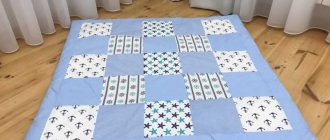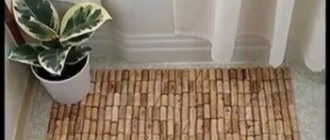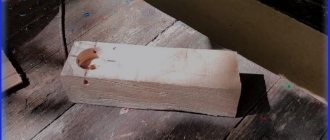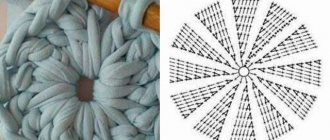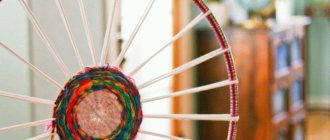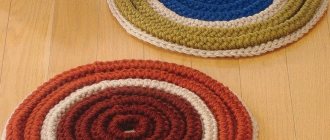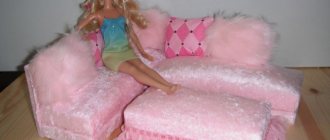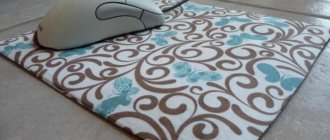Making a beautiful and comfortable soft rug for the bathroom or child’s room is a great idea even for beginners. Knitting a rug is very simple and quick. The cost of the product is not very high. All over the Internet there are many ideas for creating beautiful beautiful rugs from soft, delicate, bright or not so colorful, but muted pom pom colors.
This interior element is very pleasant for the feet, is easy to wash and looks very original.
What material is suitable?
Let's consider what features different materials for making pom-poms have:
- Yarn. A rug made from wool or acrylic threads is soft and warm. Yarn can be bought at the store or unraveled from old items. Knitting threads come in a variety of palettes, so the color of the carpet can be matched to the interior.
- Plastic. To create balls, ordinary garbage bags are used. The result is a moisture-resistant product with a massage effect. Pom-poms for such a rug should not exceed 4 cm, otherwise they will quickly wear down.
- Fur. A rug made of fur balls looks original and airy. True, working with fur is quite difficult - you should carefully handle the delicate material during production, use and washing.
- Old T-shirts. Knitwear cut into thin strips is a budget-friendly way to create a carpet from pom-poms with your own hands. The fabric balls are fluffy, dense and look very unusual.
Techniques and features of making pompoms
The step-by-step process of making a carpet from pompoms with your own hands should begin with the creation of these very pompoms.
- The simplest method, known from school labor lessons, is making pom-poms using cardboard blanks. Two circles of the same diameter are cut out of thick cardboard. It is worth considering that the larger the diameter, the larger the pompom will be. A smaller circle is cut in the center of each workpiece. Cardboard circles are aligned and thread is wound around them. The more often it is laid, the denser the pompom will be. The threads are cut on the sides with nail scissors and neatly pulled together in the middle. Afterwards, the product should be fluffed and the unsightly protruding ends should be trimmed.
- You can make pompoms more productively using a regular chair. The threads are wound between the legs. Then, the resulting “tape” is pulled together in several places and cut between the dressings. To obtain identical pom-poms, the workpiece should be separated using a measuring tape before re-upholstering.
- For small pom-poms, a similar procedure can be performed on a regular table fork by winding the threads around the tines.
- Less convenient and less productive, but still valid, is the method of making pompoms using your fingers. From two to four fingers can be involved. The thread is wound around the fingers, removed, pulled together in the center, and the loops are cut with scissors.
- For another way to make fluffy blanks for a rug, cardboard toilet paper rolls will come in handy. Before use, they should be compressed, giving the cardboard a triangular shape. Here the thread is also wound and, after cutting, pulled together in the middle. The pompom is ready!
Additional Information. The number of dressings is inversely proportional to the diameter of the finished pom-poms. If large ones are needed, dressings should be done less frequently.
Preparing the base and mesh of the carpet
- The most convenient base for a pompom mat is a construction mesh. Firstly, it can be bought at almost any construction store. Secondly, it is durable and has clearly demarcated cells, so the pompoms will be distributed evenly. And thirdly, no other base can boast such ease of attaching pompoms. There is no need for any additional equipment except the hands of a master. But to increase the speed of the process, you can use a crochet hook.
- If you don’t have time to go to the store, but have a soft cord at hand, then you can weave a mesh base from it on a homemade frame made of boards and nails. The main thing is that the size of the pompom is larger than the cell size of such a grid.
- Some people prefer a fabric backing. But not all fabric will work. For example, denim, tapestry or corduroy will hold the shape of the rug perfectly.
- An interesting option for the base is a ready-made rubberized mat from the store. The process looks like this step by step. We buy a ready-made rug of the required size with a rubber base and cover its front part with pom-poms.
Before you start forming a rug from pompoms, you need to think about its shape and patterns of possible arrangements of pompoms.
Preparation of tools and materials
Almost everything you need to create such a product is usually available at home. But even if something is missing, the acquisition will not require large expenses.
A colorful rug made of voluminous pompoms will set accents and add freshness to the interior.
You will need:
- The basis for the rug is mesh, fabric, or a ready-made rug from the store.
- New or used yarn (wool, viscose or acrylic is best), knitwear, polyethylene, fur. Yarn from loose, old things must first be moistened and straightened in order for the pompoms to be dense and beautiful.
- A compass, and in its absence a bottle, glass, etc.
- Scissors, cardboard, pencil.
- Thick needle and strong thread for sewing.
- Glue.
- Crochet hook.
If you want to make a warmer rug, you can make an additional padding made of padding polyester.
Making a carpet
Before you start making the product, you need to calculate the number of pompons, based on their diameter and the area of the substrate.
For example, to make a rug measuring 40*60 cm with a pompom diameter of 3–4 cm, you will need to make 380–400 pieces.
Such a rug will be especially relevant for the nursery; you no longer have to worry that the child will catch a cold while playing on the cold floor.
The technology for attaching fluffy elements to different bases is significantly different.
When making pompoms on the mesh, you should leave the ends of the dressing thread long enough. The pompom is attached to the crosshairs of the cells, and the remaining ends of adjacent pompoms are tied together to increase the reliability of the structure.
Think in advance about how the multi-colored balls will be arranged and in what order.
To attach it to a woven base, you need a gypsy needle and reliable thread. The reverse side of such a product is covered with fabric for aesthetic purposes. This can even be done manually by carefully tucking the edge.
Important! If the edge of the fabric is not turned up when hemming, in order to prevent it from “fringing”, it must be trimmed with piping.
Having sewn pompoms onto a rubberized mat, its reverse side with fastening points can also be hemmed with fabric.
A flight of fancy will help you create an incredible product with your own hands in the form of an animal or any geometric figure.
When making a rug, you can use glue. But it is worth remembering that such fastening is less reliable and can be used in a product that does not experience mechanical stress. For example, a wall panel.
To insulate a children's rug, it must be lined with padding polyester or felt.
Square
For the base of a square-shaped rug, it would be more practical to use a construction mesh.
Using a measuring tape, measure the backing of the required size and cut it out.
The main component of a carpet made from fluffy pom-poms is soft yarn.
Along the edge, we place the first row of pom-poms as tightly as possible. You need to try not to let them go beyond the product. The remaining protruding edge can be crocheted later. For greater density, the pompoms can be distributed in a checkerboard pattern. You should not forget to make strong knots on the reverse side so that the result of such painstaking work will last as long as possible.
Colors can be combined in different ways, as your imagination dictates.
Round
For an even base, it is better to initially make a paper template, and then transfer its dimensions to the backing. If the base is fabric, then a needle and thread are used. Sew starting from the center. If the pompoms are of different colors, textures or sizes, before fixing them on the base, you need to draw a diagram.
If the floor at home is cold, and a DIY carpet made of fluffy pom-poms will perform an insulating function, you need to consider an additional layer.
Mini mat
If you don’t have enough knowledge of how to make a rug out of pompoms, but you really want such a fluffy miracle, then you should start with a small model. The technology is the same as for a square or round product, but the number of pompoms and the size of the backing are much smaller.
To make the carpet fluffy and voluminous, pom-poms are made with a diameter of 7-10 cm.
Heart
Such a rug will look very romantic. Due to the rather complex shape, it is better to first make a paper template. To make it symmetrical, fold the paper in half, draw half a heart and cut it out. Let's expand. A beautiful, even heart is ready. Fabric or mesh will serve as a backing; we begin to attach fluffy elements from the edge, gradually moving towards the center.
Do-it-yourself heart-shaped rugs made from pink pom-poms look romantic.
Decoration
The decorative properties of a pom-pom carpet depend not only on its shape, size, pattern, but also on the material of the pom-poms. Yarn of various compositions and colors looks beautiful, but it is much more pleasant to put your feet on pompoms made of natural or faux fur in the morning. The step-by-step instructions for making such pompoms are as follows. A small circle is cut out of the fur using a sharp stationery knife on the reverse side. It is quilted along the edge and tightened. Filler is placed inside. We hold it over the steam for 15 - 20 seconds so that the fur becomes fluffy. The procedure for attaching to the base is standard.
For its decorative function, the rug does not require an additional layer of insulation.
Of course, the palm in originality goes to the carpet made of polyethylene pom-poms. An excellent option for the bathroom and outdoors. It is easy to clean and dries quickly.
Photos of rugs in the interior
Such a soft homemade accessory will add comfort to any room: bathroom, bedroom, living room. It looks especially good in the design of a children's room.
The photo shows a chair decorated with fluffy pom-poms.
What to make a pompom from
Typically, pompoms for rugs are made from leftover chunky knitting yarn. These “fluffies” retain their shape remarkably well, do not get pressed down, and can withstand washing well.
In addition, you can also use old cotton T-shirts, cut into thin strips (up to 1 cm). Such a rug will be quite heavy and will quickly lose its original appearance, but if you have a bunch of unnecessary T-shirts, why not try to make something new out of them?
There is also a third option, which is more suitable for bedspreads - tulle pompoms. Lush, bright, light, but easily wrinkled, so they are more suitable for bedspreads and decorative pillows.
Design options
A pompom rug can come in a variety of designs. The shape of the product can be in the form of a circle, square, rectangle or in the form of other geometric shapes. Often, a pom-pom carpet is made in the form of an animal skin (usually a bear, hare, sheep or fox). These varieties differ in their colors and sizes, which can be absolutely any. You need to choose the appearance of the product based on the interior design of the room in which you plan to use it.
For example, if you want to place such a soft and fluffy rug in a children's room, you can make it bright and colorful, if in an adult bedroom or living room - in delicate light colors.
DIY pompom rug step by step master class
A carpet made from this material looks very beautiful. Master Class:
- For this work you will need the following materials: knitting yarn in two colors, for example, white and blue, scissors and a base mesh. It is recommended to use plastic canvas as a base.
- You need to make pom-poms in two colors for a gradient transition. Their number depends on the size of the rug. You can also use different sizes of material to make a custom rug.
- Following the color scheme, you need to tie the materials to the base. The materials should be attached very tightly to each other so that the canvas is not visible.
- All knots must be tied tightly to prevent the pompoms from coming untied.
- The reverse side of the canvas, if desired, can be covered with a piece of fabric.
Trying to weave
To make a small, approx. up to 40 cm long, a woven rug made of threads, yarn or fabric ribbons/bundles is not needed at first. A rectangular piece of cardboard and a dinner fork will be enough. Using a fork, immediately poke holes for the base: lines are drawn along the short edges of the cardboard “machine”, at a distance of 3-5 cm from it. The first 4 holes are pierced along the line with a fork, then the fork is shifted by 3 tines so that the outer one falls into the last hole that has already been pierced, 3 more holes are pierced, etc. The cardboard is cut to the holes; The warp thread is carried out in one piece, placed in a loop under the edge petals - “pegs”. Leave the ends of the base free for approx. 10 cm each.
Then we weave, as usual, pos. 1-2 Fig., but instead of a shuttle you will have to use a gypsy needle; the shuttle will not fit between the cardboard and the fabric. Having carried out 4-10 threads of weft, depending on its smoothness, we tamp the fabric with the same fork, pos. 3. We obviously unwind the wefts in excess, because the missing thread is tied from the inside out, which is not possible in this case.
How to weave a rug without a loom
Next, the ends of the worked weft threads are left at approx. 10 cm and glued to the “camp” with tape, pos. 4. When the entire warp is woven, they are carried out with a needle under at least 8-10 weft transitions from the wrong side to the face, pos. 5, and trimmed.
The next stage is to remove 3-4 loops from the petals at one end of the base and insert the free end into them, pos. 6. We tighten it a little, but don’t cut off the “tail” yet! We do the same with the other end of the warp thread.
Now the base can be completely removed from the pegs. Place the rug approx. for a day on a flat, smooth surface for self-tightening of the fabric under the influence of residual stresses in the threads. If the loops of the base have not yet tightened completely after this, smooth the rug, tighten it, and shake it until they tighten. Now you can cut off the “tails” of the base - the product is ready for use!
In a similar way, you can weave rugs from leftover yarn or patchwork rugs from ribbons/strands (remember - jeans, tights, rags?) Both materials can be used together, but the warp and weft must be uniform. They are assembled from separate threads/ribbons, secured with knots, on the left in Fig. It remains to decide how to connect threads/ribbons that are not long enough, or to bring out the pattern. As for the threads, there is no way on a cardboard “loom”, you need to take whole ones. And 2 ways of connecting tapes are shown there in the center and on the right. You can connect very short ribbons first, but the joint will be visible. The second joint is invisible, but the overlap of the ends is needed from 4-5 cm.
Weaving a patchwork rug on a piece of cardboard and methods for joining the patches
Some tips
When manufacturing, you need to consider:
- First you need to choose a manufacturing technology. To obtain large and very fluffy pompoms, you can even use a round hoop.
- The threads must be even. If you are using yarn that was previously a product, it is recommended to wet it and dry it by hanging it on a rope. For better straightening, you can attach a small weight to the bottom edge.
- The wider the template for the pompom, the more magnificent it will be.
- The thread that holds the threads of the pompom together must be tied as tightly as possible so that it does not fall apart over time.
- To create a carpet in a certain shape, you need a pattern. This will help determine the required number of elements.
- You need to place the pompoms on the base in a checkerboard pattern, so the carpet will be more lush and even.
- Between the base on which the pompoms are attached and the lower base, you need to lay foam rubber, so the carpet will be softer.
Useful for beginners
It's not easy to create perfect fluffies the first time, but the more you make them, the better they turn out. Here are some tips for craftswomen:
- If you don’t have good scrap cardboard at hand, then use an old CD as a circle.
- To create unusual shades, the main color is diluted with other threads of similar color or, conversely, with more contrasting threads.
- To give the shape, it is better to straighten the threads first. To do this, they are wetted and placed under a press.
- The base is a plastic canvas with wide holes, made entirely of synthetic material. These cells will allow you to quickly thread thick cords to seal the product. Its edges will not unravel or crumble.
- If there is no such mesh, then stramin will do (used in the process of embroidering tapestries and panels). You can find it in any specialized craft store.
- The size of the product depends on the diameter of the circle. If you need to make a small pompom, then take a small circle and vice versa.
- To make many balls, it is better to purchase special circles at a specialized store so as not to have to worry about cutting out cardboard.
- A pompom is not only an excellent carpet component, but also a very interesting toy. The yellow one will turn into a chicken, and the white one will turn into a snowman or a sheep. Therefore, these cute little things allow you to experiment a lot.
